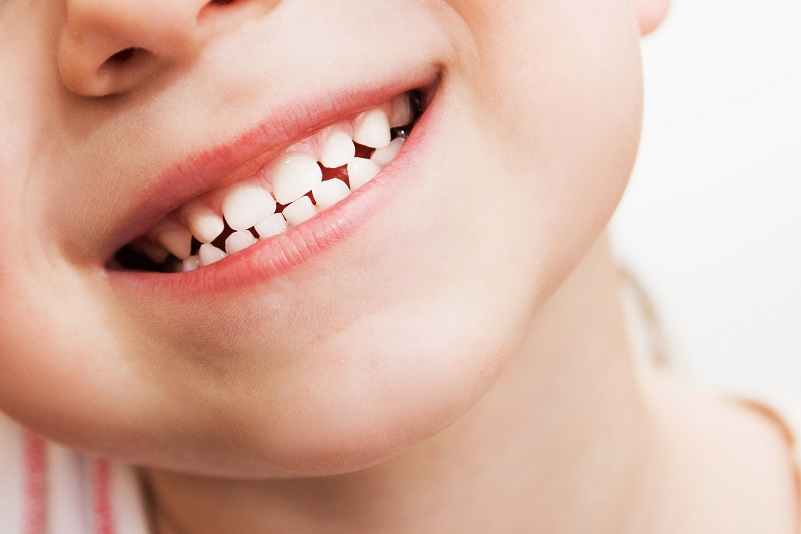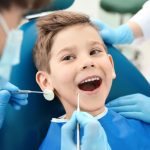A Developing Smile: The Permanent Impact of Baby Teeth
Written by Consumer Guide to Dentistry Last modified on January 21, 2019
Primary teeth (also called baby or deciduous teeth) begin to erupt through the gums between the ages of 3 and 12 months. It may take a couple of years for all 20 primary teeth to fully develop, then another three or four years until they start falling out naturally to make way for the permanent teeth.
Although primary teeth are only around for a mere fraction of the life of a smile, they nonetheless play an essential role in the health and development of permanent teeth.

Setting a Pattern
As a child grows and develops, the jaw lengthens to create space for the 12 additional teeth. There are only 20 primary teeth compared with the 32 permanent teeth that will eventually erupt. The primary teeth serve as a foundation on which the permanent teeth develop. They serve essentially as space holders to guide alignment and positioning for the underlying permanent teeth. If baby teeth are lost at too early of an age, the remaining primary teeth may shift position, ultimately affecting the alignment of the permanent teeth. Such misalignment can increase the likelihood that a child will require orthodontic correction to address misalignment or spacing irregularities.
Another issue that can result from the early loss of baby teeth relates to the development of the jawbone and its muscles, which play an important role in bite functionality. Irregularities affecting the jaw bone and/or muscles can increase the risk for malocclusion (abnormal bite alignment) and its associated concerns, such as temporomandibular joint disorder.
Natural Progression
Children will typically have a full set of baby teeth by the time they are three years old, then naturally begin to lose these primary teeth around the age of six or seven. Children likely have a full set of permanent teeth by the age of 12 to 16.
The first baby teeth to fall out are typically the central incisors (front middle teeth). These are followed by the adjacent teeth on either side, as the eruption pattern works its way to the back of the mouth and the molars. The final permanent teeth to erupt are the four wisdom teeth.
During these formative dental years, dentists should monitor the health and progression of eruption to ensure that everything is developing correctly. If a child does not lose their primary teeth by a certain age, a dentist may need to remove them in order to allow for the permanent teeth to come in. If the primary teeth remain in place too long, a permanent tooth may become impacted, which can affect other permanent teeth and alter bite alignment.
On the opposite end of the spectrum, if a child’s baby teeth begin to fall out too early, this could indicate decay or another underlying issue. Pediatric tooth decay is the most common chronic disease affecting children ages 6 to 11 according to the CDC. Sadly, nearly one in five children in America are without dental care. Consumer Guide to Dentistry is a sponsor of the National Children’s Oral Health Foundation (NCOHF), America’s Toothfairy, and its mission to help protect these underserved youths and lessen the impact that pediatric decay has on the health and wellbeing of many children’s smiles.
Caring for Baby Teeth
Organizations like NCOHF have your back when it comes to helping safeguard the dental health of children, but there are steps that parents can (and should) take to prevent any potential problems themselves.
Most importantly is scheduling a first visit with a pediatric dentist by the time your child is one year old. Although your child is unlikely to have baby teeth at this point, your pediatric dentist can provide helpful hygiene tips and ensure a mouth-friendly diet is adhered to. Pediatric dentists can also share valuable information about common dental health pitfalls like nursing bottle syndrome (Check out common red flags for poor oral health in your child).
Your best action during the early days of oral hygiene for your child might be as simple as wiping down the gums with a clean, damp cloth. As your child grows older and their baby teeth develop, then you should be more proactive, and supervise and oversee things like teeth brushing, fluoride treatment, dental sealants and more.
For a complete list of recommendations, check out our Keys to Preventing Pediatric Tooth Decay section. You can also check out some of the NCOHF-sponsored programs aimed at helping to educate children about the importance of oral health care.






